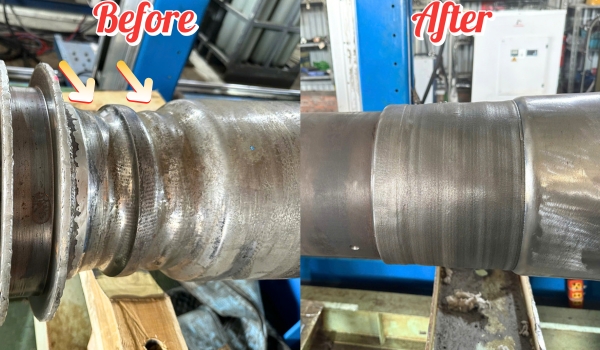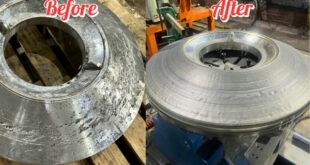
Generator Shaft Journal and Wear Condition
The shaft journal is a critical component in a generator, responsible for centering and transmitting the rotational motion between the rotor and its connected parts. During continuous operation, it is subjected to high loads, friction, vibration, and elevated temperatures, leading to surface wear, erosion, or pitting.
When the shaft journal becomes deeply worn, the clearance increases, causing reduced efficiency, bearing vibration, and even severe damage to the rotor–stator assembly if not repaired in time.
Limitations of Traditional Repair Methods
Conventional methods such as chrome plating, thermal spraying, arc welding, or stick welding have been widely used for journal repair, but they reveal several limitations in cases of deep wear or high precision requirements.
Plating or spraying only creates a mechanical bond, which can easily peel off under heavy load or vibration.
Arc or stick welding produces a metallurgical bond, but the wide heat-affected zone often causes deformation, cracking, or distortion of the shaft.
Moreover, the dimensional accuracy after repair is limited, requiring extensive post-machining to meet generator tolerance standards.
Therefore, for severely worn journals or parts requiring high precision, Laser Cladding offers a far superior and safer solution.
Laser Cladding – The Optimal Repair Technology
Laser Cladding is an advanced surface restoration technology that uses a high-power laser beam to melt alloy powder and a thin layer of the base material, forming a strong metallurgical bond.
This process allows precise layer-by-layer deposition, restoring both the original dimensions and the mechanical properties of the shaft journal according to its design specifications.
Outstanding Advantages of Laser Cladding:
- Effectively restores deeply worn areas while maintaining high geometric accuracy.
- Creates a strong metallurgical bond that resists peeling and delamination under heavy load.
- Minimizes the heat-affected zone, preserving the base material’s mechanical properties.
- Offers a wide range of alloy powders with excellent wear and corrosion resistance.
- Reduces machine downtime and replacement costs.

Practical Application at PHUONG DONG INDUSTRY
At PHUONG DONG INDUSTRY, Laser Cladding technology is professionally applied to restore large-capacity generator shaft journals.
The process includes: inspecting and measuring the wear area, selecting the appropriate alloy powder (Inconel, alloy steel, nickel, chromium…), performing high-power laser cladding with precise layer control, followed by grinding, polishing, and final dimensional inspection according to technical standards.
After restoration, the shaft journal achieves excellent dimensional accuracy and durability — equivalent to or even better than a new part — ensuring stable generator operation and significantly extending service life.
Conclusion
For generator shaft journals with deep wear, Laser Cladding stands out as the most advanced and sustainable repair solution today.
Thanks to its precision, durability, cost-effectiveness, and reduced downtime, Laser Cladding is becoming the new standard in industrial maintenance and component restoration.
PHUONG DONG INDUSTRIAL AND TRADING CO., LTD
Address: Alley 70, Dan Di, Uy No, Dong Anh, Hanoi
Phone/Zalo/Whatsapp: +84 987 822 360

 Laser Cladding Phương Đông
Laser Cladding Phương Đông


